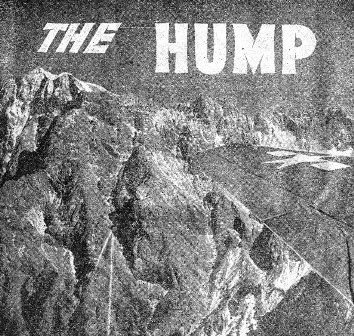
VOL. II NO. 29 REG NO. L5015 DELHI, THURSDAY MARCH 30, 1944
MOGAUNG - The fierce impetus that drove Lt. Gen. Joseph W. Stilwell's Chinese-American force through bitter Japanese resistance at Jambu Bum Pass last week had today pushed through to the village of Shadazup where they found the bodies of more than 250 additional enemy dead.
Meanwhile, the three-pronged invasion of India's Manipur State by the enemy appeared to peril Stilwell's main supply line up the Assam-Bengal Railway, but an official spokesman for the Southeast Asia Command stated in a press conference that eventually the Japanese would be forced to engage the main strength of the defending troops. This, the spokesman said, would almost certainly result in a Japanese defeat because of superior British strength.
250 JAPS KILLED
The 250 Jap dead in the Chinese-American action were troops pocketed in the upper finger of the Mogaung Valley and who fought with suicidal desperation before finally abandoning their positions.
It is estimated that this force numbered 1,000 including anti-tank and field artillery units, and that the mauled survivors escaped through a loophole in the encirclement to the southwest.
BITTER STRUGGLE
Fighting raged for a week and the Chinese forged slowly forward against Japanese dugouts, bunkers and foxholes and through incessant artillery and mortar fire. The enemy fought literally to the death, with instances reported where the Chinese, attacking with superb courage, jumped into Jap dugouts and shot and bayoneted it out with the occupants. Tanks of the Chinese-American detachment frequently trundled into the action.
Latest communiqu places the Chinese across the Hkwangiaw River, three miles above Shadazup. They occupied Hkawnglayang on the other side, after killing 60 Jap soldiers and four officers and are now attacking a hill position 1,500 yards south of the river. Of significance, a road block is reported established three miles south of Shadazup.
"It is possible," writes Till Durdin , New York Times correspondent, "that the Japanese now fighting in the north of the valley are suicide troops with the mission to hold until the last, while defenses and troop dispositions are completed for the defense of Mogaung, 40 miles southward. These Japanese have shown no disposition to make a general withdrawal."
In the pocket cleared by the Chinese, an American liaison officer counted 180 Jap dead on the east side of the road in a half-mile square area and more than 60 on the opposite side. He also reported that he had observed many freshly-dug graves.
In pursuit of the Japanese, the Chinese are now pushing down the east side of the main road of the valley and hacking trails through the dense jungles of the hilly country. They have also had to contend with recent rains. Meanwhile, other Chinese and American detachments are attacking the enemy's flank at points east and southeast of Shadazup after an outflanking march over the hills through the jungles parallel with the road. The enemy is resisting stubbornly to prevent the outflanking forces from cutting off their main artery of communications southward.
Supporting the ground operation, American bombers, dive-bombers, fighter-bombers and fighters have been' active, disrupting troop concentrations, ammunition and gasoline dumps, communications and stores.
In the Fort Hertz area, the British commando force of Ghurka troops and Kachin levies have occupied the village of Tingpai along the Sumprabum-Myitkyina Road.
SENATE PASSES ‘G.I. BILL OF RIGHTS’
WASHINGTON (UP-ANS) - Not a dissenting vote was cast when the Senate was polled upon the "G.I. Bill of Rights," a measure providing $3,000,000,000 worth of benefits for veterans of World War II and an additional $500,000,000 for the construction of new hospital facilities.
While the legislation allows no bonus - two other bills have, so far, been drawn up for such payments to veterans - it would set up a program of government-paid education of from one to four years for servicemen and women; veterans job placement bureaus; loans up to $1,000 for purchase of farms, houses and businesses; and unemployment compensation of $15 weekly for a maximum of 52 weeks.
CHAMPIONED BY CLARK
Jointly sponsored by the American Legion and the Veterans of Foreign Wars, the "G.I. Bill of Rights" was introduced in the upper house by Sen. Bennett Champ Clark (D.-Mo.) and was approved in short order last week in the sanctity of the finance Committee.
Sen. Walter F. George (D,-Ga.) estimated that not more than 10 percent of the veterans will accept the full year's education provided in the bill. He pointed out that the Research branch of the Morale Services Division has ascertained that seven percent of the men think they will actually return to full-time school and college after the war, whether they receive government aid or not.
HOUSE TO VOTE
The "G.I. Bill" provides for tuition up to $300 yearly for the veterans returning to school, plus allotments of $50 monthly for a single man and $75 for a married man.
Having passed the Senate, the measure has gone to the House for a vote.
Meanwhile, no further word has been heard since their introduction last week in the senate of two proposed bonus bills. One calls for a maximum of $4,500 for overseas service and $3,500 for home duty; the other, scaled more modestly, asks a top figure of $1,250 for overseas duty and $1,000 for domestic assignment.
DEFEAT OF JAPS CLOSER
CHURCHILL LAUDS BURMA JUNGLE FIGHTERS
LONDON - Prime Minister Winston Churchill, addressing the United States by radio this week, predicted that the war with Japan might take less time to win than was at first thought possible and lauded the Allies for displaying individual fighting skill and courageousness in the Burma jungle.
"We have placed a powerful battle fleet under Admiral Somerville in Indian waters to face the main threat of the Japanese fleet, should it turn westwards after having declined battle against the Americans," he added.
Churchill revealed that U.S. Army Air Forces in Britain have grown larger than the Royal Air Force here. He admitted the campaign for Italy had not progressed as well as hoped, but emphasized that it had removed 90 Italian divisions from the conflict and continues to tie down 25 German divisions. He also praised the 900-mile advance of the Russian Army and hailed the imminence of the "hour of action" in Western Europe.
ZOOT SUITS
MILITARY POLICE NAB TWO G.I.'S
The CBI got what was probably its first glimpse of American "zoot suits" outside the movies this week at APO 885 (Delhi). However, it was only a glimpse, for the two G.I.'s, who were enveloped in jitterbug covering, were speedily jerked in by the Military Police.
They had the conventional khaki color. But the trousers were pegged, the bush jackets reached half way to their knees and their ties were twice the ordinary size in width.
One of them explained the pegged trousers as "a protection against malaria."
MAJOR BAGS ‘WHATIZZIT’ - CHINA G.I.’S CONFOOZED
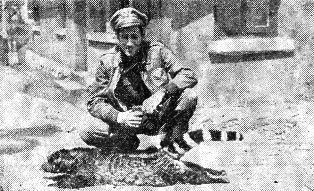
China Bomber Squadron Baffled |
CHINA AIR BASE - Hunting is about the only recreation available to G.I.'s of this advanced air base, and the lads up here spend quite a bit of their spare time either doing it or talking about it. But all tall tales of the year-round hunting season were topped for good here recently, when Maj. E. C. Weatherly came in with the lifeless carcass of a local whatizzit that is driving the local zoological experts screwy.
When he first saw it, Weatherly thought it resembled the raccoons he had often hunted in his native hills of North Carolina. But, after his .45 had done its duty, he approached the dead animal to discover that it was something completely out of this world. It resembled a raccoon from behind, a badger from the front, with possibly a soupcon of alley cat amidships. After minutes of bewilderment and confusion, he at last shouldered his unusual bag and set off for camp.
There confusion was worse confounded. The best minds of the outfit were called in to name the creature, but the best they could make out of it was that it was the kind of animal only seen after too-extensive bouts with your jing bau juice. To settle the elusive mystery, the carcass was embalmed by the squadron photo lab and sent over the Hump to the Calcutta Zoological Society for identification.
Eventually, the answer came back. Weatherly had been fortunate enough to have snared the first specimen in 50 years of the very rare Liao-shian-bao Wootze, which translated from the Chinese means, "Shy, Introspective, four-footed being, half raccoon, half cat, half badger, who eats succulent bamboo shoots in the spring." The Society was delighted to get such a fine specimen and requested permission to use it as the central figure in a new exhibit of extinct and near-extinct Asiatic fauna.
The Eagle Squadron scores again!
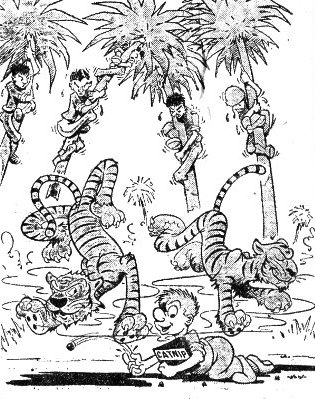
|
Silver, twin-engined Lightnings plunged swiftly from the sky this week in an American P-38 squadron's first major action over Burma and scored a smashing victory over a mixed force of Japanese fighters which outnumbered them 3-1 with 35 plus ships. When the fight was over, crashed Zeros littered the Anisakan airfields over which the action took place. The box score was seven Japs destroyed, two probably destroyed and three damaged in the air; two destroyed on the ground and three probably. This at a cost of two pilots of the Third Tactical Air Force of the Eastern Air Command.
Lt. Bill Duke, of Leonardtown, Md., sent one Zero to destruction and shared in dispatching another. He said: "Over Anisakan, I spotted eight fighters to my right and a little below. I pulled up and went down on the first. I gave him a short burst and missed. I climbed again, got on another fighter and gave him a fairly long burst straight into his cockpit. I pulled up again and saw my wingman, Lt. J. Smith, shooting at him. He burst aflame and crashed into the ground. I saw another plane below me a gave him a long burst. I saw my cannon shells strike true and the Jap burst into flames."
Leader of the first flight, Lt. Hampton E. Boggs, of Garvin, Okla., former Oklahoma A&M student, related how he first blew up an enemy in mid-air, caught a second on the ground and caused the first to crash and then hit a third on the ground. Lt. A. H. Greco, Salinas, Calif., one of the two U.S. pilots missing in the action, destroyed a Zero on the ground while accompanying Boggs. Lt. King, of Norfolk, Va., fired at an enemy that barreled between him and Boggs and saw him spin into the ground.
Lt. J. P. Wrights Carver, Pittsburgh, Kan., second flight leader, destroyed another Zero, while probables were credited to Lt. R. A. Hargis, of Warren, Ark., and Lt. W. M. Behrns, San Joacquin, Calif.
SLOW PROGRESS MADE ON ARAKAN FRONT
BURMA BRITISH FRONT - British forces in the Arakan are making slow progress, while the situation on the 180-mile Chindwin front remains confused, with the British remaining confident their announced superiority in air and ground forces would sweep back the Jap forces which crossed the Chindwin River in three columns.
The British announced Jap troops had penetrated to within 30 miles of Imphal, but that the Imphal garrison had taken the offensive, wiping out one Jap pocket north of the town.
At Tiddim, 160 miles south of Imphal, British troops set up box defenses similar to the ones used in the Arakan. But later in the week the British announced the Tiddim-based troops had taken the offensive and had successfully attacked Jap positions overlooking the Tiddim-Imphal Road.
Troops from Tiddim were moved up the road to meet the threat to the British right flank provided by the enemy cutting of the Tiddim-Imphal Road. Severe fighting took place at Tonzang, 17 miles north of Tiddim. Several Jap tanks were destroyed.
The Japs are threatening one of the two main Imphal-Tiddim roads at Tamu. heavily armed Nip forces, including tanks, are in the Kabaw Valley, east and southeast of Tamu. The British announced destruction of five Jap tanks in this action.
The Royal Indian Navy also entered the Burma picture by a bombardment of enemy positions on the Mayu Peninsula. Several targets ashore were set ablaze.
Theater SOS Keeps Ship Unloading Lead Third Straight Time
For three straight two-week periods, Maj. Gen. W. E. R. Covell's Services of Supply has stood at the top in overseas theaters in the speed with which they are unloading ships in ports in India.
American troops and equipment working day and night along the docks in India's harbors have cut the average time of unloading a Liberty ship down to six and one-half days.
Port Battalions in CBI have maintained an average daily discharge per port of 50 percent more tons than the average of all other overseas theaters. For the period from February 16 to February 29 they were running close to 100 percent higher.
A new record was recently established at one Indian port for the unloading of a Liberty ship. Under the direction of Port Transportation Officer John E. Meyer, of Great Neck, Long island, N.Y., men working the port in this East India harbor discharged 7,115 long tons of cargo from a ship in the net working time of 64 hours.
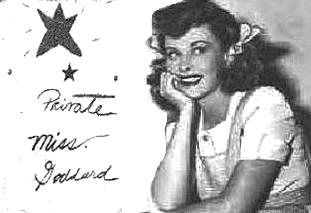 This dressing room rigged up for La Goddard "somewhere in CBI-land" is a far cry from the ones she knew in
Hollywood, but the comely actress was appreciative of the thoughtfulness.
This dressing room rigged up for La Goddard "somewhere in CBI-land" is a far cry from the ones she knew in
Hollywood, but the comely actress was appreciative of the thoughtfulness.
|
La Goddard Entertains G.I.'s At Maingkwan
By Sgt. SMITH DAWLESS (Erstwhile Bard of Assam)
ALONG THE LEDO ROAD - American and Chinese troops who had just taken Maingkwan blinked. A vision of loveliness was manifesting itself in the Burmese jungles. It moved; it smiled. It wore a stunning Hattie Carnegie creation. It was Paulette Goddard, ready to entertain the G.I.'s with the able support of Bill Gargan, Keenan Wynn and the magic-fingered piano accordionist, Andy Arcari.
For all their wishful thinking, no one thought La Goddard would actually get that far. The Japs were only a few miles away. The ground was pocked with bomb craters, liberally sprinkled with dead Japs. No preparations had been made. But in 10 minutes, a detail of grinning Chinese had put up a tent.
"Next time," they promised La Goddard through an interpreter, "we put up a tent for you in Tokyo."
La Goddard was definitely not gun-shy. She asked to go up to the front lines. But Lt. Gen. Joseph W. Stilwell put his foot down. "Not one foot farther," ordered Uncle Joe. Period.
To husband her time, Paulette flew to her next evening's stand in an L-4, escorted by four fighter planes. From then on, she and the rest of the troupe bumped merrily down the Ledo Road in an ambulance (vertically), stopping off at camps along the way.
La Goddard arrived in the Ledo area with plenty of hardware on her smart OD suit: Signal, Medical and Engineer Corps insignia, ATC pin and the Presidential Citation Ribbon for flying The Hump over Jap-held territory.
After a month of sleeping in cots and jungle hammocks, she was delighted to find a bed in the bungalow loaned to her by Brig. Gen. Lewis A. Pick.
"Do you know," she said, opening her blue eyes wide, "I had to have someone especially to keep the rats out of my tent on the way down."
"What kind? we asked naively, "two-legged or four?"
"Oh," she cooed vaguely, "big ones."
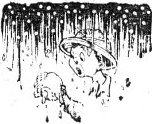
|
HIT BY NATURE IN ASSAM
APO 487 (Dinjan, India) - 'Twas a beautiful day in Assam -- if you looked in the right direction. On one horizon lay azure skies, peaceful cotton clouds and the sun shone brightly; on the other side huge sable rain clouds glowered, thunder crackled ominously, and a stout wind smelled of rain. Weather officers became hard to find, airplanes didn't know whether to fly or flee. It was a meteorological jackpot.
So it hailed. Big, hard hailstones the size of walnuts, rattling viciously off the corrugated iron roofs, felling birds in flight, breaking windows. Everyone stood around and talked about the weather, but nobody did anything about it, except get under cover, to keep from being beaten to death.
But when it stopped, G.I. ingenuity took over. The war effort went to Hell while the boys swarmed outdoors to sweep up the glistening icy marbles and carry them off by the bucketful. For what? Why, to cool beer, and one gang even whipped up a batch of ice cream. One doesn't see ice up here once in a coon's age. 'Twas a beautiful day in Assam.
China P-40 Ace Returns Home To Shangri La
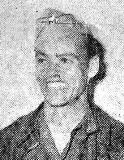
|
14TH AF HEADQUARTERS - The CBI Theater has lost one of its outstanding aces this week when Lt. Col. Elmer W. Richardson, 27-year-old Butler, Pa., P-40 fighter pilot, was ordered back to Shangri La after 39 months of foreign service in China and Panama.
Richardson leaves behind him an outstanding record of 213:45 combat hours on 108 missions for the 14th Air Force, during which he destroyed seven enemy fighters and one bomber in the air, three on the ground, and is credited with three probables. He takes home with him the right to wear the Silver Star, the Distinguished Flying Cross and the Air Medal with the Oak Leaf Cluster.
Since October, 1943, Richardson has been commander of a P-40 squadron known to the Japs as the "White Nose" squadron. Credited with destroying 112 enemy aircraft in the air, probably shooting down 60 more and destroying eight on the ground, this squadron has run up the highest score of any fighter squadron in the CBI Theater. Previously, he had been squadron adjutant, executive officer and operations officer.
Richardson arrived in China as a first lieutenant, but his ground and air exploits were so outstanding that he rose in 17 months to his present exalted status with only an eagle between him and the stars.
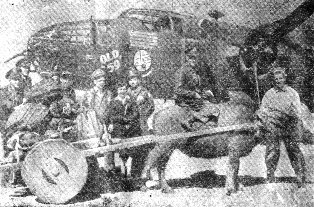 A Chinese oxcart provides transportation for this crew of the 14th Air Force's "Ringer Squadron," which, with "Old 59,"
may already have taken of for Shangri-La on a bond-selling tour after having completed 121 combat missions. The crew
consists of Lts. Robert Ebey, George R. Jernigan, Hilliard O. Peavy and Paul J. Sjoberg; S/Sgt. Lyle A. Wilson; Sgt.
Rudolph Madsen and Cpl. Francis Donnelly.
A Chinese oxcart provides transportation for this crew of the 14th Air Force's "Ringer Squadron," which, with "Old 59,"
may already have taken of for Shangri-La on a bond-selling tour after having completed 121 combat missions. The crew
consists of Lts. Robert Ebey, George R. Jernigan, Hilliard O. Peavy and Paul J. Sjoberg; S/Sgt. Lyle A. Wilson; Sgt.
Rudolph Madsen and Cpl. Francis Donnelly.
|
In Final Rites
HEADQUARTERS, 14TH AIR FORCE - He died on Armistice Day, just 25 years after the "War to End War" came to an end.
The Chinese didn't know that, for Nov. 11 means nothing in their calendar. They did know, however, that his plane had flown like an eagle in the skies over China, that he had fought like a hero against China's hated enemies, and that when his day came and his plane fluttered down to crash on one of China's hills, he had died manfully.
So, the next day, 4,000 Chinese gathered solemnly, to carry the body of Capt. Lowden M. Enslen, of Springfield, Mont., to its last resting place. Most of them were Chinese guerillas, who also live with death in their unceasing war against the invader. Others were regular troops and local officials.
The body, dressed in new clothes, was placed in a heavily-hewn wooden Chinese coffin, painted vermillion, and was then interred with solemn rites in a grave dug in a hill near where the plane fell. Around the grave was erected a staunch brick wall, and on it was erected a wooden tablet on which "a detailed account of the heroic deeds of Capt. Enslen were inscribed."
News of the impressive ceremony was received at this headquarters via letter. Following confirmation of Enslen's death, he was awarded the Distinguished Flying Cross posthumously for participating in 48 combat missions as a fighter pilot in North Africa and South China. Enslen has three enemy fighters to his credit, and once dive-bombed and sank a 500-foot ship.
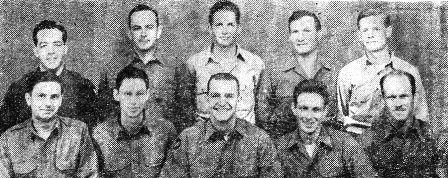 Scoring 21 victories without a defeat, this AACS cage club in China captured the Rice Paddy League title by
defeating a Bombing Group team 26-24.
Pictured here, front row, left to right: Lt. Boyd, Sgt Hobson, Cpl. Maceau, Cpl. Dowell and Sgt. Briggs; second row:
Lt. Smith, Sgt. Costello, S/Sgt. Hughes, Cpl. Mercer and Sgt. Greer. Not present for this photo were 1st Sgt. Geise
and Cpl. Knapp.
Scoring 21 victories without a defeat, this AACS cage club in China captured the Rice Paddy League title by
defeating a Bombing Group team 26-24.
Pictured here, front row, left to right: Lt. Boyd, Sgt Hobson, Cpl. Maceau, Cpl. Dowell and Sgt. Briggs; second row:
Lt. Smith, Sgt. Costello, S/Sgt. Hughes, Cpl. Mercer and Sgt. Greer. Not present for this photo were 1st Sgt. Geise
and Cpl. Knapp.
|

|
AACS Cagers Cop Pennant
In China Play
CHINA - Climaxing a successful season, the AACS cagers displayed their fighting spirit and teamwork by coming from behind in the last two minutes of play to win over a Bomb Group outfit, 26-24. This victory enabled the AACS to emerge as winners of the Rice Paddy League with the claim of "Champs of China."
In 21 games this season, the AACS were unbeaten. In addition to wins over neighboring G.I. clubs, the AACS stopped three of the top-notch Chinese teams, who numbered among their players several veterans from China's 1936 Olympic team which, incidentally, gave the Nazis a good show in Berlin with their fast-breaking style of play.
S/Sgt. Dick Hughes, closely followed by Cpls. Mel Maceau, Dick Powell and Bill Knapp, led the AACS in piling up 652 points for a 31 point per game average as compared to the 374 total of the opponents, who averaged 17 points each contest.
Credit for defensive prowess is given Sgt. Art Hobson, who proved a tower of strength in the back court, along with Lt. James Smith and Lt. Irvin Boyd.
The AACS were often extended to the limit in sweeping to victories in both halves of the league season and no game was more exciting than the finals of the round-robin, in which they scored their two-point triumph over the bombers.
For most of the season the team was intact, but mid-season transfers of Maceau, a former Marquette football player, and Sgt. Irwin, coach, might have proved fatal except for the capable replacements of 1st Sgt. Bob Geise, and Sgts. Joe Greer, Joe Costello and Loyal Briggs.
|
|
When the history of the war in the CBI Theater is written, a glowing chapter will describe the deeds of the Air Transport Command's epic Hump-jumping operation. These photographs by Bill Vandivert, of Time, Life & Fortune, portray in part one of the typical flights over the rocky spine of the Himalayas from India to China. By spanning one of the most treacherous sectors in the history of flight with vital sinews of war the Hump fliers have done much to help China stoutly maintain its resistance to the Japanese, who seized the nation's seaports and blockaded the interior. Now the Ledo Road is also reaching out insistently toward a China recently isolated except for the ATC operation. |
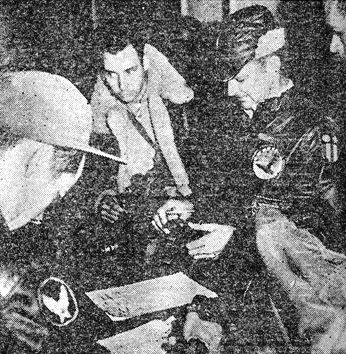 Pilots and crews check in at operations for a dawn take-off. Weather report is ice to 23,000 feet.
Pilots and crews check in at operations for a dawn take-off. Weather report is ice to 23,000 feet.
|
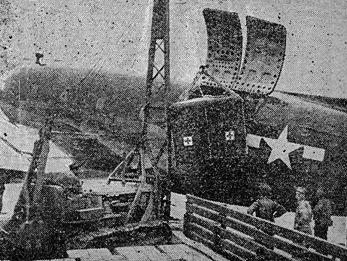 Cargo planes, carry everything from heavy machine lathes to artillery pieces to lead pencils.
Cargo planes, carry everything from heavy machine lathes to artillery pieces to lead pencils.
|
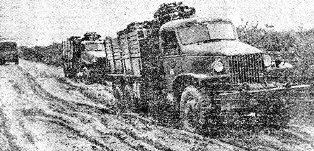 G.I. trucks carry cargo vital to China's remaining in the war to and from airfields along monsoon-swept roads,
often bogged down by mud.
G.I. trucks carry cargo vital to China's remaining in the war to and from airfields along monsoon-swept roads,
often bogged down by mud.
|
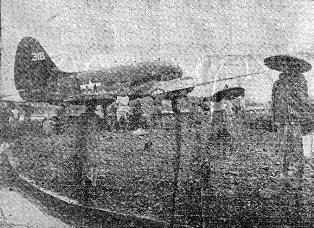 Indian laborers bend their backs to construct hard standing on a dispersal area near a runway as a Hump-hopping
transport plane taxis preparatory to taking off.
Indian laborers bend their backs to construct hard standing on a dispersal area near a runway as a Hump-hopping
transport plane taxis preparatory to taking off.
|
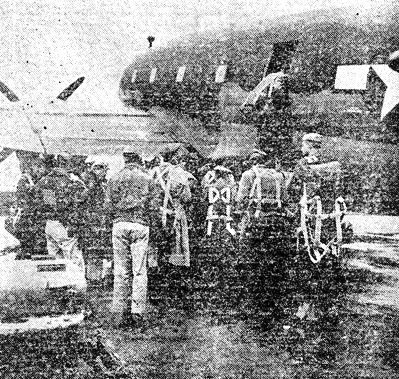 China-bound passengers board a transport plane somewhere in India for their ride over The Hump.
China-bound passengers board a transport plane somewhere in India for their ride over The Hump.
|
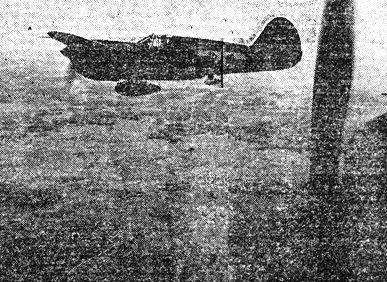 An industrious little P-40 fighter plane protects the lumbering transports hurdling the Himalayas.
An industrious little P-40 fighter plane protects the lumbering transports hurdling the Himalayas.
|
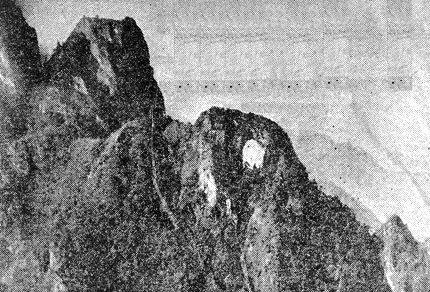 A natural bridge, forming a hole large enough to hold a four-story house, is a landmark often photographed by
Hump passengers.
A natural bridge, forming a hole large enough to hold a four-story house, is a landmark often photographed by
Hump passengers.
|
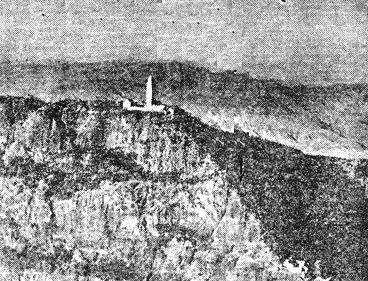 Another landmark which helps pilots during flight is this Buddhist monastery perched on a Chinese mountain top.
Another landmark which helps pilots during flight is this Buddhist monastery perched on a Chinese mountain top.
|
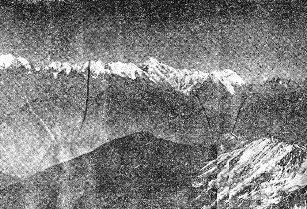
|
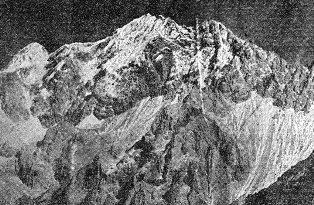
|
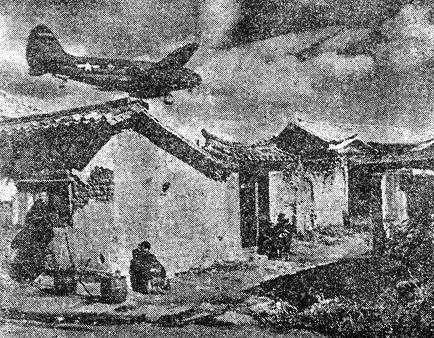 Approaching a landing field in China a plane wings over a village, whose inhabitants now are so accustomed to the
sight they seldom look up.
Approaching a landing field in China a plane wings over a village, whose inhabitants now are so accustomed to the
sight they seldom look up.
|
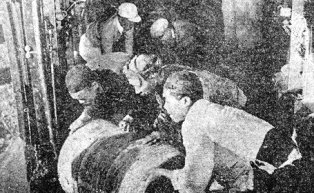 Coolies at a field in China unload another vital cargo in short order so that the plane may make the return trip in
the quickest possible time.
Coolies at a field in China unload another vital cargo in short order so that the plane may make the return trip in
the quickest possible time.
|
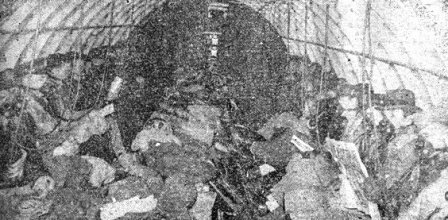 Interior of a plane during flight. From 10,000 feet up, oxygen is needed. A cross-section of passengers might include
Army personnel from privates to generals, civilian technical experts and diplomatic officials.
Interior of a plane during flight. From 10,000 feet up, oxygen is needed. A cross-section of passengers might include
Army personnel from privates to generals, civilian technical experts and diplomatic officials.
|
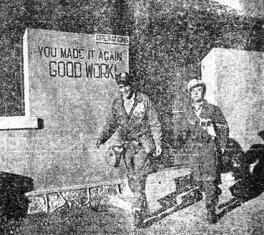 Plane crews report to the operations shack on the China side of The Hump, ready to make the return flight.
Plane crews report to the operations shack on the China side of The Hump, ready to make the return flight.
|
EAC BOMBERS HIT RAILROAD IN SHARP RAID
EASTERN AIR COMMAND HQ - Most spectacular raid of the week by Eastern Air Command was the attack on the Burma-Siam Railway, vital line by which the Japs are supplying their army and air force in Burma now that bombing has denied them Rangoon.
The attack, at dusk on March 23, was the first low-level bombing of this objective. B-24's of the Strategic Air Force attacked from as low as 500 feet, their bombs falling along the railway line. Two bridges were destroyed, five were probably destroyed and two were damaged. One locomotive was destroyed, one train was derailed and another train damaged.
DUMPS MAIN EFFORT
Main effort by night of the Strategic Air Force for the rest of the week was against supply dumps in south Burma - dumps built up from the equipment carried into Burma by rail from Bangkok. There was, however, no raid on a scale comparable with that against dumps in the Rangoon area the week before. Prome was twice attacked. A fire was seen by B-24's after the first raid on March 21-22 when the crews were 60 miles away from the target on their way home. Moulmein and Martaban, important links in the chain of communications from the Burma railhead to central and north Burma, were again bombed.
For the first time in daylight, heavy bombers of the Strategic Air Force on March 26 turned their attention to the Chin Hills, bombing troop concentrations on the Imphal-Tiddim Road. Dumps and supply bases along the Chindwin were bombed by heavies and mediums during the week and Shwebo rail yards were twice attacked. Most northerly target was the Mogaung dumps, attacked on the 25th.
The tactical Air Force had another busy week. towards the end of the period, squadrons of dive-bombers were switched from the Arakan to the north to launch attacks against enemy troops, positions, lines of supply and bases in the Chin Hills, the Chindwin Valley and northwest Burma.
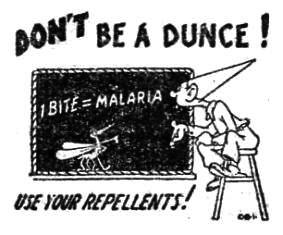
|
OIL FIRES SET
Fighter-bombers were also thrown into this all-out offensive, aimed at disrupting the Japanese columns striking towards the Indian border. The combined bombers had their busiest day on March 26 when a record number of sorties over this area was flown. Again and again on this day Vengeances struck at vital targets. In one attack north of Tonzany two large oil fires were started with black smoke rising to 15,000 feet.
With the activities of the dive-bombers being diverted to the northern area at the end of the week, fighters came into their own over the southern battlefront and concentrated on communications in the Arakan, Mayu and Kaladan.
Altogether during the week, they destroyed 78 river craft besides damaging many more that number. In their bag were five 50-foot power launches and four 50-foot riverboats.
Long-range fighters were again active against enemy communications this week extending their operations up into north Burma. Typical of the success of their sorties were the operations of March 20 when two locomotives were destroyed and 11 damaged, six of them heavily damaged. Next day another two locomotives were destroyed. Medium bombers and long-range fighter-bombers also played their part in these operations against the Japanese lines of supply.
During the first half of the week, fighters and fighter-bombers were active in support of Lt. Gen. Joseph W. Stilwell's troops in north Burma.
HOUSING PROBLEM
Caused by Assistant Air Chief
The impending move of the Eastern Air Command Headquarters to the Bengal area has brought about a housing problem.
The difficulty does not stem so much from the number of officers and enlisted men involved but has been brought about involuntarily by Air Vice-Marshal T. M. Williams, assistant air commander to Maj. Gen. George E. Stratemeyer.
There is no inference here that Williams is any sort of a dog in the manger. The trouble is that the former rugby star is too big. He is six feet, one inch tall, makes the Fairbanks groan at 210 pounds and looks twice that big. He's rough, rugged and has a chin about as prominent as the Taj Mahal.
ROSE FROM PRIVATE
As a private in the 12th South African Infantry during the German East campaign in the last war, he got bored and decided to become a flyer. He was commissioned, defied the ordinary laws of gravity by finding an airplane that would lift him off the ground, and wound up by shooting down 17 Germans. In so doing he picked up a lot of hardware like the Military Cross, the DFC and was mentioned in dispatches.
At the outbreak of this war he was senior operations officer of the No. 1 Bomber Group in France, a position he held until the evacuation. He was again decorated with the Order of the British Empire.
STARTED IN JAVA
He started off against the Japs in Java in 1942 as Senior Air Officer under Air Chief Marshal Sir Richard Peirse. In March of that year he came to Delhi as Senior Air Staff Officer. As Air Officer commanding the RAF, Bengal Command, he sent up the night fighters which stopped the Jap raids on Calcutta. He is now Stratemeyer's assistant and hasn't much time for his hobbies of photography and refereeing rugby matches. He and Strat seem to be working up heep good scrum and lots of Jap wickets will get knocked down or is that mixing the metaphor?
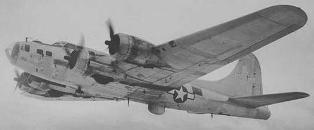 Sans war paint, Flying Fortresses are 60 pounds lighter and able to streak to and from their targets 10 miles an
hour faster. A shiny plane aloft is just as hard to spot as a camouflaged one.
Sans war paint, Flying Fortresses are 60 pounds lighter and able to streak to and from their targets 10 miles an
hour faster. A shiny plane aloft is just as hard to spot as a camouflaged one.
|
The fact that the CBI Theater is continuing to grow up was proved again this week when a shower of new Theater newspapers hit the editorial desk of the Roundup in a volume amounting to a deluge.
Just to list the papers brought to the Roundup's interested attention by the mailman this week requires more space than somewhat. From APO 627 (China) comes the Turn About Times . . . from APO 630 (Gaya, India) , the Blow-It-Out . . . from the 47th Air Depot the India Ink . . . from the 305th Air Service Command Group the Yankee Doodler . . . from APO 629 (Chabua, India), The Banshee . . . from the 31st Signal Battalion, the Cross-Talk . . . from some unidentified source, the Bakshish . . . and from the 782nd M.P. Battalion, the MP Blotter.
The majority of these papers are mimeographed sheets, although the Bakshish is handsomely printed in two colors. All of them do a fine job of covering local doings as they should be covered, in down-to-earth G.I. jargon and with the kind of intimate details about local personalities, from brass hats to privates, that people like to read. Undoubtedly, they are doing an important job in keeping morale as high as possible in the areas they cover.
On a larger scale, a new, eight-page weekly has made its bow in an East India port, the Command Post, which undoubtedly will do much to relieve war weariness in that busy sector of American activity in India. Well-printed, well-edited, well-written, with a judicious balance of straight news features and pictures, the Command Post is a big-time effort that will compare favorably with Army newspapers anywhere.
BARBER ONLY PFC WITH 14-MAN SALUTE
Mike Runs Latrine Rumor Clearing House
UPPER ASSAM BASE - Pfc. Michael Maroscia, of Cicero, Ill., known to the boys as Mike of Assam, runs a G.I. barber shop in this primitive jungle land, with his tonsorial den serving as a clearing house for latrine rumors and neighborhood gossip.
The boys straggle in, clad in dusty flying togs or dirty fatigues. They usually order the works: shave, haircut, massage and shampoo. It looks like a big night. Two hours later they reappear clad in clean khaki, Theater ribbons and polished shoes. They're back for the nightly bull session.
Assam Mike is the character who presides over the sessions. He boasts, "I'm the only private first class in the Army who rates a 14-man salute." He has 14 Indian barbers and before they "bas" at night, they high-ball him and say, "Salaam, sahib."
"We got plenty of big shots going through here," says Mike. "See that chair? Joe E. Brown got his best shave and haircut there. Gen. Stilwell inspected the shop, too. Lots of brass, all kinds, come here, just before going over The Hump. They all tell me what a swell shop I have and toss me lots of compliments. But, look, I'm still only a private first class."
Mike gets plenty of beefs from G.I.'s because of his price of one rupee for a haircut and eight annas for a shave. He blames it all on transportation. His barbers all come from outlying villages, and, taking pride in their work, charge what he calls "Assam Union rates."
Every night he throws a G.I. party for his 14 subjects. They scrub everything, even if it's clean. Then the barber king stands back and crows, "Watch this." Comes the 14-man salute.
As they leave, Mike of Assam grins, "Funny, isn't it? - I worked for a living, and then I came into the Army and now Uncle Sam has made me an employer."
|
FATHER MEETS SON AT ASC BASE 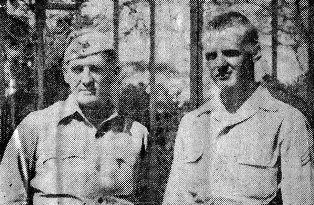 DESMONDS - SURPRISE MEETING
DESMONDS - SURPRISE MEETING
|
The Roundup's (quote) It's A Small World (unquote) file is swelling into such proportion that we are thinking of binding them into booklet form. Today we have yet another, but it has a new twist.
Capt. Leo F. Desmond, of an ASC base in India, often declared in his letters to Chicago that "I'm not within walking distance of home." He hadn't seen his son, Bob, since they parted in Dearborn Station in the Windy City.
But you've already guessed the incredible story. Upon whom did the captain's eyes gaze the other day in a dusty chow line in India? None other than Bob, wearing two stripes. We repeat (quote) It's A Small World (unquote).
P.S.: And yet another. Cpl. Larry Jaffe writes a frantic note that his path has crossed that of his brother, Lt. Frank Jaffe, "somewhere in China." Frank walked into Larry's tent and they agreed that (you know what).
CARBON COPY PEORIA, ILL., ON LEDO ROAD
ON THE LEDO ROAD - Shadowed by the dust of the Ledo Road and hidden away in the Burma jungles lies a tract of land that not long ago was occupied by the Japs but now bears the title of "Little Peoria."
The reason for the appellation is a sound one - for here live 145 officers and men, all from Peoria, Ill., who walked out of the Peoria Caterpillar Tractor Co. plant en masse on Oct. 1, 1942, to enlist in the U.S. Army Engineers.
Every building on the grounds and every tent is named after some well-known Peoria tavern, business house or public building. The C.O., Capt. Jean Walker, occupies a tent labeled "The Chamber of Commerce"; the first gadget, Clyde Chenowieh, lives in "Buehler's Old People's Home"; the latrine is "The Snakehouse"; headquarters "The Courthouse"; the supply room is "The B & M Dry Goods"; and the day room is "The Peoria Journal-Transcript." All the streets of the tent city are named after Peoria thoroughfares.
Everything runs smoothly in the camp, with none of the "home State" arguments which sometimes plague the peace of other establishments. The G.I.'s only have two problems now - how to get a company of Peoria WACs assigned to the neighborhood, and what steps to take to get a Peoria distillery transplanted into the heart of the jungle.
MITCHELLS ACTIVE AS 14TH AIR FORCE ROARS INTO ACTION
14TH A.F. HQ. - Mitchell bombers of the 14th Air Force played an important role during the past week in weakening Japanese rail communications. On March 23 they swept into French Indo-China, attacking the rail yards at Van Trai. Two locomotives and 11 freight cars, one containing ammunition, were destroyed. The planes then damaged three rail bridges along the line between Than Hoa and Vinh.
Two days later, the bombers again flew to French Indo-China to destroy strings of railroad cars four miles north of Vinh, at Yen Ly and at Hoang Mai. Other installations were also hit at Than Hoa. At the same time, Liberators blasted a motor pool and fuel dump near Hangshin, on the Burma Road, scoring many hits in the target areas.
On March 26, Mitchells raided Jap shipping and rail equipment on Hainan Island. Over Bakli Bay, the bombers, incomplete reports show, sank one 1,200-ton and one 1,000-ton enemy vessel. Railroad trackage and loading equipment were destroyed. From these missions, all planes returned safely.
Wingate Leads Invasion Force In Daring Move
WITH WINGATE IN BURMA - The spectacular airborne invasion of Burma, which placed Maj. Gen. Orde Charles Wingate's Long-Range Penetration Troops 200 miles into enemy territory and established a road block that isolated the Japs fighting Lt. Gen. Joseph W. Stilwell's Chinese-American forces to the north, is described "like taking an island in the Southwest Pacific."
The analogy begins with the taking of a small isle in the heart of enemy territory by the Commando Force under Col. Philip (Flip Corkin) Cochran and the building of an airfield. Hard on the heels of this operation, the Troop Carrier Command flew in British-Indian troops to hold it.
PRINCIPLE FOLLOWED
Thus, with the same tactics successfully evolved by U.S. forces in the Marshall Islands, a seemingly impregnable fortress was taken in an area firmly held by the Japanese since they took Burma in May, 1942. It was a beautiful display of the principle of combined operations.
Discussion of the plan to accomplish penetration by the daring use of planes and gliders, instead of tedious walk-in, was first discussed after the Quebec Conference by Admiral Lord Louis Mountbatten and Gen. H. H. Arnold, who are said to have worked out details with Cochran.
Cochran was given a free hand in gathering personnel and equipment. Arnold then sent Cochran's Commando Force to report to Gen. George E. Stratemeyer in India and the plan was co-ordinated with overall Southeast Asia Command strategy.
OFF-AGAIN, ON-AGAIN
Not until this week was it announced that the penetration groups, made up of British and Ghurkas, are under the leadership of Wingate.
"Some people," said the shrewd, daring, picturesquely-bearded Wingate, "said it would not be possible to operate an air strip on enemy territory. Air logistics were against it. Others considered the proposed employment of gliders impracticable as shown by other unsuccessful use in Sicily. Many times during the period of preparation, I was warned that the scheme might be off. In spite of this, I always assumed that my plans would go through and would be found the only ones which in difficult conditions governing military operations on this front would be feasible."
Wingate declared that the swift advance of this year's operation over that of last was "20th Century and, by comparison, last year was medieval."
Morale, he said, was high, for his troops know that they can be evacuated by air if wounded. "The most awful thing (last year) was having to leave the sick and wounded behind."

PIN-UP GIRLS Resort to cutting paper dolls again. Bold scissors rob the picture magazines And thumb-tacks paper walls with movie queens. Alike, enlisted lads and officers, Collect from Hollywood photographers. They look for Petty girls and plan to seize The Varga-idealized anatomies. Men claim in black-and-white or warmer tones Chili Williams, Choo Choo Johnson, Candy Jones, Rita Hayworth and those happy shining names, Of bathing suit, sarong or sweater fames. Jane Russell, Lan Turner, Betty Grable And Dorothy Lamour - so gladly able To capture fleeting beauty in a pose For pin-ups, like rare butterflies, in rows BY SGT. G. ELWOOD JONES, JR. |

|
|
Song Introduced
BY FOUR ACES LEDO ROAD - The Four Aces, Negro quartet which has been knocking the cats out with solid jive along the Ledo Road, introduced a new song the other night at a performance for officers and men at an evacuation hospital entitled Jumping at the Hindu Hall. Several months ago, the quartet introduced the song everybody is whistling on either side of the Burma-India border, Who's Taking My Place With Her Now? The Four Aces, who have entertained more than 10,000 men in the past five months with a wide variety of tunes ranging from Ink Spots arrangements to their own sentimental style are available for performances. Write to Pvt. Raymond Robinson, APO 689. |
‘DRESS NEATLY, BOYS,’ WARNS SOS GENERAL
Responsibility for discipline and observance of uniform regulations for all areas in the Communications Zone in CBI-land, with the exception of posts and stations of the Ground Forces or Air Forces, has been placed squarely upon the shoulders of the Services of Supply.
This was made known in a letter to SOS troops by Maj. Gen. W. E. R. Covell, who praised them for the recent record for neatness and discipline and stressed the fact that American soldiers on foreign soil are representatives of their government and, as such, must make a good impression.
"I have confidence," said Covell, "that the men of the Services of Supply in this Theater of Operations will cooperate and 'play ball' with us in helping to discharge our new responsibility."
Tricky Question
OH, WHAT TO TELL JUNIOR AFTER THE WAR
"Pop, what did you do to win the war?"
This question, which will inevitably be asked by curious little Junior, appears to the Roundup to pose a tricky post-war problem overlooked by the majority of serious thinkers.
Shall the old man, a veteran of CBI-land, let down the tyke and bring him up to shame in the eyes of his playmates by admitting the plain, unvarnished truth: "Shucks, son, I was third assistant cook at a Godforsaken base in Central India."
Or shall he make Junior's eyes bug out with pride by spinning fanciful tales of hobnobbing with Maharajas,
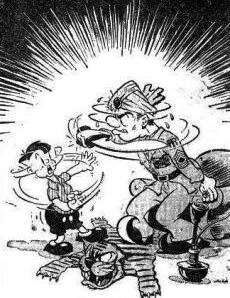 "THERE I STOOD - MY BACK TO THE COW PADDIES - SURROUNDED !"
"THERE I STOOD - MY BACK TO THE COW PADDIES - SURROUNDED !"
|
This particular problem was brought to the Roundup's attention today after reading a Hairbreath Harry interview given a credulous Cleveland fishwrapper by a M/Sgt. Bernard C. Gleeson, just arrived in Shangri-La after 22 months in this Theater.
When and if the sergeant dangles a youngster on his knee, Junior will receive a Homeric picture of his old man having been a cross twixt Gen. Douglas MacArthur and Dr, Henry M. Stanley. If the rest of us should decide to adopt Gleeson's policy, his interview serves as an admirable guide for what to tell Junior.
"It is nothing," admitted Gleeson modestly, "to pick up four or five Jap spies on the field. They come from everywhere, and life is so cheap Indians will do spying or killing for a little money. It is not unusual in the morning to find a soldier who has left the barracks to walk a short distance to another during the night stabbed to death."
Why sergeant!!
"It is nothing," he blithely continued, "for a soldier to walk out of his tent in Assam and find a tiger less than 20 feet away." Other juicy quotes: "For recreation, we walked into the jungle five minutes away to hunt." ... "We had a swimming hole that was a beauty. The crocodiles weren't bad - we shot one only 30 feet away." ... "The temperature hit 140 and, when flying, we used gloves to operate the dials on the instrument panel they became so hot." ... "We got home with nothing more than 100 bullet holes in our plane (an ATC transport)" ... "One Nag headhunter said he had about 65 heads from the last year." ... "Bombing made cobras and tigers appear just as an ordinary nuisance not to be bothered with."
It seems to us as if the sergeant brought a case of Fighter Brand whiskey home with him and tucked himself away with a bottle before the interview. But if the American press is prepared to accept these wild tales, it may be a swellelegant idea to do our part. After all it makes priceless reading and if it suggests to the body polite that Sgt. York was only a tin soldier who should we be to complain? A CBI patch would certainly be worth a slug of free drinks at any bar, if everyone cooperated.
Pardon us while we change typewriters. A Jap Zero just fired a burst through the window and shot up the keyboard. Copy boy, will you please brush that cobra off the fan? When you get around to it, Lt. McClaughry, shoot those three Jap spies who broke into the office last night. Sgt Derr, have you fed our pet leopard? And Cpl. Heenan, tell that maharajah it's against Army regulations to accept that trunkful of star sapphires for running his picture this week.
WAR CASUALTY TOLL HITS 165,061 FOR U.S.
WASHINGTON - (ANS) - The Office of War Information put casualties of the U.S. armed Forces since the start of the war at 165,061, of which 38,846 were killed, 58,964 wounded, 35,521 missing, 31,370 prisoners of war. The Army dead totals 21,014, while Navy, Marine and Coast Guard dead is 17,832.
1,500-MILE PIPELINE STARTS OPERATION
LINDEN, N.J. - (ANS) - The 1,500-mile pipeline from Texas was in operation this week, delivering oil to the Eastern Seaboard Line, and is scheduled to deliver 5,000,000 gallons daily.
An explosion of a 40,000-barrel reception tank in an eastern terminus here sent flames 100-feet in the air and an estimated 1,000,000 gallons of gasoline were destroyed.
IMPRESSION

|
OF CHINESE G.I.'S ABOUT YANKS
MOGAUNG VALLEY - Here's the average Chinese G.I.'s impression of his American ally.
He'll tell you he likes "megaw" (the American) and appreciates the fact that he has come to help China.
Ask him what he knows about megaw soldiers and he'll tell you, "They came many miles across the waters from a great city of high buildings and are very wealthy." Any attempt on your part to convince him that Americans also come from farms and mountains similar to the Chinese will meet with disbelief.
He is adamant in his conviction that all Americans live in a fabulous skyscraper city.
The C.B.I. Roundup is a weekly newspaper published by and for the men of the United States Army Forces in China, Burma, and India, from news and pictures supplied by staff members, soldier correspondents, the United Press, and the Army News Service. The Roundup is published Friday of each week and is printed by The Statesman in New Delhi, India. Editorial matter should be sent directly to Lt. Floyd Walter, Rear Echelon Hq., U.S.A.F., C.B.I., New Delhi, and should arrive not later than Monday in order to make that week's issue. Pictures must arrive by Sunday and must be negatives or enlargements. Stories should contain full name and organization of sender.

MARCH 30, 1944
Original issue from the collection of C.B.I. Roundup Correpondent Al Sager, shared by CBI veteran Dave Dale.
Copyright © 2006 Carl Warren Weidenburner
| Notes: The photograph of Candy Jones has been added to this Internet recreation and was not published in the original issue of Roundup. A similar, alternate image of the B-17 was used to replace poor quality scan. APO address locations have been added following the APO number. |
TOP OF PAGE PRINT THIS PAGE ABOUT THIS PAGE SEND COMMENTS
PREVIOUS ISSUE CLOSE THIS WINDOW NEXT ISSUE
